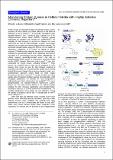Monitoring Protein Kinases in Cellular Media with Highly Selective Chimeric Reporters
Author(s)
Lukovic, Elvedin; Taylor, Elizabeth Vogel; Imperiali, Barbara
DownloadImperiali15_Lukovic-Angew-2009.pdf (694.4Kb)
OPEN_ACCESS_POLICY
Open Access Policy
Creative Commons Attribution-Noncommercial-Share Alike
Terms of use
Metadata
Show full item recordAbstract
Protein kinases are important regulators of cellular function, and the dynamics of their activities are critical indicators of the health or pathology of living systems.[1, 2] In particular, extracellular-signal regulated kinases 1 and 2 (ERK1/2) play a pivotal role in the mitogen-activated protein kinase (MAPK) signaling pathway responsible for regulated cell survival and proliferation.[3] The centrality of these enzymes in normal and diseased cell states underscores the need for high throughput, selective, and sensitive methods that accurately and directly diagnose kinase activities. The benchmark phosphorylation assays for ERK1/2 rely on transfer of radioactive γ-phosphate of [γ-32P]ATP to peptide or protein substrates.[4] While broadly employed, this approach has limitations, including the discontinuous nature of the radioactive assay and the non-native ATP concentrations that are utilized. Alternatively, for cellular imaging, genetically-encoded sensors that rely on phosphorylation-based changes in fluorescence resonance energy transfer (FRET) between fluorescent protein pairs[5, 6] have been constructed for several kinases, including ERK1/2.[7-10] These sensors are powerful because they can be expressed in cells, however, they cannot be used for high throuput screening of recombinant enzymes and unfractionated cell lysates due to the very limited fluorescence changes that accompany phosphorylation. As a complementary approach, probes based on small, organic fluorophores with direct readouts[6, 11] can give sensitive and robust signals under physiogical conditions and are thus amenable to high throughput applications. For example, we have incorporated a sulfonamido-oxine (Sox) chromophore into peptides[12, 13] to report phosphorylation via chelation-enhanced fluorescence (CHEF) (Figure 1a). The weak binding affinity of the unphosphorylated substrate for Mg2+ increases significantly upon phosphorylation, resulting in robust (2- to 12-fold) fluorescence enhancements. This versatile peptide-based sensor design has been applied to monitor the activity of numerous Ser/Thr and Tyr kinases both in vitro[13] and in cell lysates.
Date issued
2009-08Department
Massachusetts Institute of Technology. Department of Biology; Massachusetts Institute of Technology. Department of ChemistryJournal
Angewandte Chemie
Publisher
Wiley-Blackwell Pubishers
Citation
Luković, Elvedin, Elizabeth Vogel Taylor, and Barbara Imperiali. “Monitoring Protein Kinases in Cellular Media with Highly Selective Chimeric Reporters.” Angewandte Chemie 121.37 (2009): 6960–6963.
Version: Author's final manuscript
ISSN
0044-8249
1521-3757